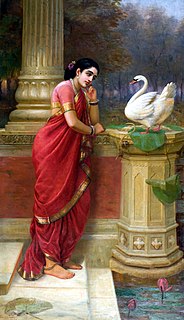
Damayanti is a character in a love story found in the Vana Parva book of the Mahabharata. She was the daughter of Bhima and a princess of the Vidarbha Kingdom, who married King Nala of the Nishadha Kingdom. The character is also found in other Hindu texts by many authors in numerous Indian languages. She, along with Nala, are the central characters in the 12th century text Nishadha Charita, one of the five mahakavyas in the canon of Sanskrit literature, written by Sriharsha.

Ekalavya is a character from the epic The Mahābhārata. He was a young prince of the Nishadha, a confederation of jungle tribes in Ancient India.

Athana is a raga in Carnatic music. It is a Janya raga, whose Melakarta raga is Dheerasankarabharanam, 29th raga, commonly known as Shankarabharanam in the Melakarta system.
Utkala Kingdom was located in the northern and eastern portion of the modern-day Indian state of Odisha and also included the districts of Bankura, Purulia and Midnapore districts of West Bengal. This kingdom was mentioned in the epic Mahabharata, with the names Utkala, Utpala, and Okkal. It is mentioned in India's national anthem, Jana Gana Mana.
Nishada is the name of a tribe mentioned in ancient Indian literature. The ancient texts mention several kingdoms ruled by this tribe. In the Mahabharata, Nishadas mentioned as tribes that have the hills and the forests their abode. They are linked with a king called Vena who became a slave of wrath and malice, and became unrighteous. Brahmanas slew him. Some of Vena's descendants became Nishadas and some others were called Mlechchhas, who resided on the Vindhya mountains (12,58).
Mahishmati was an ancient kingdom in present-day central India. It was located in present-day Maheshwar in Madhya Pradesh, on the banks of Narmada River.

The gold-ringed tanager is a species of bird in the family Thraupidae. It is endemic to Colombia.
Nishada is a genus of moths in the family Erebidae. They are found in India, Sri Lanka, Myanmar, Sumatra, and Borneo.
Tilang is a raga in Indian classical music, that belongs to the Khamaj Thaat.

Kāpi is a popular rāga in Carnatic music, the classical music of South India. Kāpi is a janya rāgam of Kharaharapriya with a meandering vakra scale. Typically performed at slow and medium speeds, it is capable of inducing moods of devotion, pathos and sadness in the listeners. Kāpi is different from the Hindustani raag and thaat Kafi. The equivalent raag in Hindustani is Pilu

Bilahari is a rāgam in Carnatic music. It is a janya rāgam from the 29th melakarta scale Sankarabharanam. It is a janya scale, as it does not have all the seven swaras in the ascending scale. It is a combination of the pentatonic scale Mohanam and the sampurna raga scale Sankarabharanam. It is a morning rāgam.
Olivella aureocincta is a species of small sea snail, marine gastropod mollusk in the family Olivellidae, the dwarf olives.
Peristernia aureocincta is a species of sea snail, a marine gastropod mollusk in the family Fasciolariidae, the spindle snails, the tulip snails and their allies.
Nishada flabrifera is a moth of the family Erebidae. It is found in Sri Lanka, India and on Java.
Nishada chilomorpha is a moth of the family Erebidae first described by Snellen in 1877. It is found on Java and in Sundaland, the north-eastern Himalayas and Taiwan. The habitat consists of various lowland forest types, except heath forests. It is also found less frequently in lower montane forests.
Nishada benjaminea is a moth of the family Erebidae. It was described by Walter Karl Johann Roepke in 1946. It is found on Sulawesi.
Nishada brunneipennis is a moth of the family Erebidae. It was described by George Hampson in 1911. It is found on the Moluccas.
The Lithosiina are a subtribe of lichen moths in the family Erebidae. The taxon was erected by Gustaf Johan Billberg in 1820.

Punnagavarali, a raga in Carnatic Music, is a derived scale from Hanumatodi, which is the 8th melakarta Raga in the 72 melakarta system.

Niṣāda, also known as Nishada or Nishad, is the 7th svara from the 7 svaras of Hindustani music and Carnatic music. Nishada is the long form of the syllable नी. For simplicity in pronouncing while singing the syllable, Nishada is pronounced as Ni. It is also called as निषाद in the Devanagri script.




